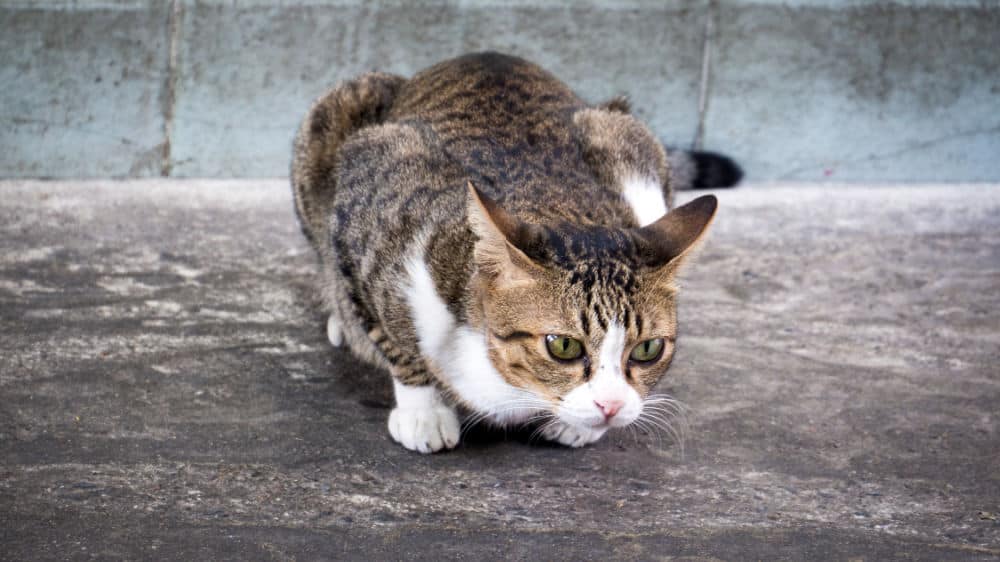Can Feral Cats Be Domesticated?

If you are a cat lover, you have no doubt seen the pictures of cute cats living on the street or in colonies. And we wish we could give them all loving and comfortable homes. But is that possible for a cat that has learned to fear humans?
Taming feral kittens is possible and highly recommended if the young cats have been abandoned. You can raise them to a domesticated lifestyle and turn them into indoor cats.
However, TNR (Trap-Neuter-Release) might be more appropriate for adult ferals. Before you decide to TNR or domesticate a cat, let’s first see the difference between feral and stray cats.
Cat Attitudes is reader-supported. When you buy through links on our site, we may earn an affiliate commission.
Ferals vs. Strays
An important distinction to make is the difference between feral and stray cats. Both are “community cats” and both are in equal need of your help, each in its own way.
Strays are cats that have lost their way home. Meaning that they once belonged to home and were properly trained and socialized.
Meanwhile, the term “feral” is used to refer to cats that were never domesticated before; born into the wild.
Socialization skills are usually the main difference between both types. This is also what makes handling feral cats that much harder. They’ll be scared of you and might act aggressively in self-defense.
You can also tell the difference by appearance. Feral cats have always been on the streets and they have learned to take care of themselves pretty well. They also live in colonies so they are protected by each other.
Strays, on the other hand, will look disheveled, starved, and even matted. That’s because, for the longest portion of their lives, they were used to being fed and taken care of.

How to Help a Feral Cat
The first step to catching a community cat is trapping it. Feral cats can be harder to approach than strays, but it’s not impossible.
Trapping Kittens
Before trying to domesticate kittens, always check that they’re truly abandoned. Find a spot, hide, and watch. Is the mother coming back to them? Is any other colony cat taking care of them?
Once you’re 100% sure that the kittens have been abandoned, get a cage ready. Try to make it as warm and comfortable as possible. We’d recommend a soft fabric cage since younger ferals aren’t very feisty, yet.
Trapping Adults
Trying to trap adult feral cats can be very risky. They are more than willing to scratch and bite their way out of captivity. It’s always just better to call a cat rescue team to pick the cat up.
They’ll be trained to handle these situations and they’ll have all the necessary tools. Double door trap cages are best for capturing ferals. They’ll also have humane capture nooses, gloves, cage isolators, and more.
The cage is baited and placed around the cat’s resting spot. Once the cat is in, the trap door closes shut. The rescuer then checks the cat for any visual signs of trauma or illness. Then they carry the cage carefully (with gloves on!)
What Comes Next
The next stop is at the veterinarian. If you can’t go directly to the vet, try to keep the cage in a quiet place around your house. Offer the cat food and water but stay out of sight as much as possible. Here’s where cage covers come in handy.
Once it’s time for the appointment, the vet will check for mites, worms, and injuries. They’ll also check to see if the cat has been microchipped or neutered before. Keep in mind that many ferals require sedation before this check-up. Don’t attempt to do it yourself!
If the cat hasn’t been neutered yet, the vet will set up an appointment to get the cat fixed. Any other issues or infestations can be handled with a prescription.
Taming Feral Cats
Let’s just start by saying that it’s possible to domesticate a feral kitten. You might be in for a challenge if you try to tame adult ferals, though.
Instead, there are different approaches to try based on the cat’s behavior and readiness to socialize.
Domestication
For younger feral cats, you have a good chance of turning them domestic. As they grow, they’ll get used to human interaction and living indoors. They’ll probably be tamed after a month or even less.
You can then either keep them with you or turn them over to a shelter to be adopted. We’d recommend that you foster them in your care till they’re adopted, though.
It’s also better to avoid separating the litter. At least till the kittens work on their socialization skills. You don’t want separation anxiety added to the mix.
The TNR Approach
If the cat’s very feisty and you can’t see any hope of domesticating it, you might want to consider a TNR approach. Get the cat neutered and then release it back where you got it from.
There are a lot of ways that TNR helps both the cat population and the neighborhood. Almost all feline rescue operations condone it as a standard practice.

If you’re trying to domesticate an adult cat, keep your expectations realistic. The cat might warm up to you over time and let its guard down. However, the cat will never be a sweetie cuddly ball of fur.
The Indoor-Outdoor Approach
One other approach that often works for friendly feral adults is TNR followed by semi-domesticating the cat as an outdoor cat.
That means caring for the cat daily without forcing it to be a full-on indoor cat. The feral will slowly turn into a “neighborhood cat” that’s healthy, happy, and friendly.
Keep in mind that even ferals can grow dependent. If you’re feeding an outdoor cat, you should be willing to do it permanently. Any community cats that gather around for feeding time might grow dependent on you, too.
Keeping Ferals with Indoor Cats: Is It Possible?
Keeping kittens with older cats is always a risky move. Let the kitten grow a bit before you let them mix up with your pet cats. For friendly adult ferals, wait till the cat is used to you and indoor settings before you introduce new cats.
When you do let them mix, always monitor them. Keep an eye on their interaction and make sure that there is no pestering. Older cats often fight with weaker ones over food and territories. Remember that ferals are usually more aggressive than pet cats. This lady is one of the best at working with feral cats.
Before you let your pet cats interact with ferals or strays, make sure they’re clear of any infectious diseases. Community cats often carry dermatological infections.
For ferals, these infections might be sub-clinical. Meaning that the disease is there, but there are no clinical signs of infection. A pampered pet cat (with lower acquired immunity) will be seriously impacted.
Final Thoughts
At the end of the day, whether you can domesticate a feral cat or not will be up to the cat. Some will actually come around pretty quickly and others will never completely embrace living their lives close to humans or indoors. Patience is key and Churu Cat Treats are great motivators.
